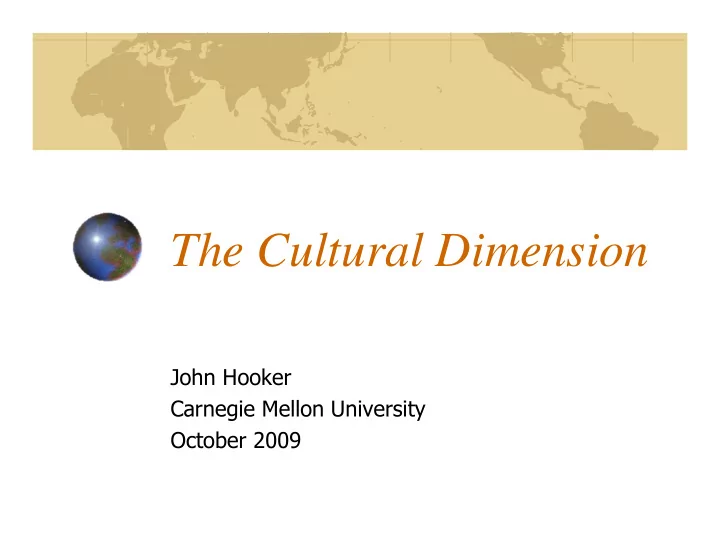

The Cultural Dimension John�Hooker Carnegie�Mellon�University October�2009
Outline A�cross�cultural�perspective Relationships�vs.�rules Competition�and�risk Culture�and�political�power
A Cross-Cultural Perspective
What culture is not Culture�is� ���� primarily�about�food,�language,�dress,� customs,�holidays.
• What�if�all�Chinese�ate Sauerbraten� and Spätzle • rather�than� jiăo�zi� and� bāo�zi?
• What�if�all�Chinese�ate Sauerbraten� and Spätzle • rather�than� jiăo�zi� and� bāo�zi? • It�would�be�the�same�culture!
What culture is Culture�is�about� ������������ . It�determines�our�deepest�assumptions,�most�of� which�we�not�even�aware. Like�an�iceberg,�culture�lies�mostly�beneath�the�surface.
Language Dress, hairstyle Pop culture Cuisine Overt religion Concepts Guilt vs. Concept of of space shame authority and time Rule-based Management Apollonian vs. of information vs. relationship Universalizing Dionysian -based rationality? Covert religion Stress Fundamental management conception of reality
Culture vs. personality Every�culture�contains�the� ����� ������ of�human�personalities. Culture�is�about�the�framework� into�which�these�personalities�fit,� ��� about�”national�character.” However,�different�personalities� succeed�in�different�cultures.�
Relationships vs. Rules
Two types of cultures There�are�5000+�cultures�in�the�world,�all�very� different. But�they�can�be�classified�roughly�as: ������������������ �����������
Relationship�based� =�life�is�organized�primarily� around� ���������������������� . Africa,�Asia,�Middle�East,�South�America
Rule�based� =�life�is�organized�primarily�by� ����� . Australia,�Europe,�North�America
Meetings Personal�connections�vs.�strictly�business Deals Personal�trust�vs.� contracts�&�law Trust�the� ������� vs.�trust�the� ������ . Traffic�behavior Negotiation�vs.� regulation. Traffic�in�China
Dealing�with� ������ Family�&�friends�vs.�technology�&�engineering. Filipino�family
Concept�of�authority. Relationship�based�– authority�rests�in�the� ������ . Rule�based�– authority�derives�from� ����� . Custodian�of�the�Two�Holy�Mosques� King�Abdullah�bin�Abdul�Aziz�Al�Saud
Many�cultural�traits� ���������� with�the�rule�based,� relationship�based�distinction. Relationship- Rule-based based High power distance Low power distance Shame-based Guilt-based High-context Low-context Corruption as Corruption as bribery cheating
Power distance �������������� is�the� degree�to�which�less� powerful�people� ������ their�subordinate�position.�
Relationship- Rule-based based High power Low power distance distance Shame-based Guilt-based High-context Low-context Corruption as bribery Corruption as cheating
Relationship�based countries� tend�to�be� ����� power� distance. Behavior�is�regulated�by� ������� with�authority. Rules�are�legitimated�and� enforced�by�authority�figures. Leaders�are�expected�to�be wise�and�caring. Example:�Deng�Xiaoping� Deng�Xiaoping De�facto�leader�of�China� 1978�1992
Rule�based�countries�tend�to� be� ��� power�distance. People�respect�the� ����� more� than�superiors. Example:�Sweden. Karl�XVI�Gustaf Swedish�King�since�1973
High�power�distance: Children�obey�and�respect�parents,�teachers. Employees�are�reluctant�to�challenge�the�boss�or�discuss� problems. • Guangzhou�executives • Filipino�maids
High�power�distance: Ideal�boss�is�benevolent�or� fatherly�autocrat�(rarely�female). Large�differences�in�salary/skills. Class�differences,�limited�upward� mobility. Dalit�(untouchable) India
Low�power�distance: Children�are�allowed�to�contradict�their�parents. Two�way�discussion�in�classroom. Discipline�may�be�a� problem;�parents�side� with�child�rather�than� teacher.�� No�corporal�punishment.
Low�power�distance: Consultative�management. Employees�bring�concerns�and�grievances�to�the�boss. Ideal�boss�inspires�workers.� Labor�unions. Smaller�salary�differences;� workers�may�resent� executive�perks. • Scandinavian�vs.�U.S.�offices. • Power�distance�higher�in� U.S.�business Solidarity�logo,�Poland
Shame and guilt ����� and� ����� are�mechanisms�for�enforcing� behavior�norms.
Relationship- Rule-based based High power distance Low power distance Shame-based Guilt-based High-context Low-context Corruption as bribery Corruption as cheating
������������������ cultures�enforce�behavior� norms�by� ����� . Loss�of�face. Humiliation. Punishment�on�the�spot. Direct�and�constant�supervision. • Department�store�cashier. No�guilt. • Shohei�Nazawa�and�Yamaichi�Securities • JAL�Flight�123�(1985),�Yusomoto�Takagi apologized�&�compensated�victims’ families.��Boeing�apparently�at�fault.
Key�point�for�shame�based�cultures: Failure�to�supervise� ����������������� to�break�the�“rules.” • Public�transit. • Exam�cheating. • Government�regulation.
����� is�more�important�in� ���������� cultures. Guilt�encourages�obedience�to� rules�without�supervision. But�it�may�be�a�poor�motivator� and�carry�high�psychological� cost. • Ein�gutes�Gewissen�ist�an� sanftes�Ruhekissen. Guilt�is�reinforced�by�fear�of� punishment.
Context In� �������������������� ,�information�and�behavior� norms�are�spelled�out. Typical�of�rule�based�cultures. The�rules�are�spelled�out. In� ��������������������� ,�these�are�implicit�in�the� cultural�context. Norms�are�transmitted�by�the�people�around�you. Particularly�authority�figures.
Relationship- Rule-based based High power distance Low power distance Shame-based Guilt-based High-context Low-context Corruption as bribery Corruption as cheating
In� ������������ cultures,� There�any�many� ����� ,� timetables,�maps. ��������� are�written,�long,� and�detailed. • Fixed�once�signed. • Disputes�resolved�by� lawsuits. People�expect�the�rules�to�be� in�writing. People� ����������������� ������������� . • Example:�restroom�sign.
In� ������������� cultures,� People�already�know�what�to�do. ��������� are�vague,�verbal,�or�nonexistent. • Except�in�“low�uncertainty�tolerance”�cultures,�e.g.�Latin� America. • Agreements�evolve�with�the�situation. • Legal�system�weak. • Disputes�resolved�by�negotiation. People� ��� ������������������� ������������� . • But�good�for�high�tech�information� transfer.
Corruption ���������� is�behavior�that� undermines�a�cultural�system. So�corrupting�behavior�is� ��������� across�cultures.
Relationship- Rule-based based High power distance Low power distance Shame-based Guilt-based High-context Low-context Corruption as Corruption as bribery cheating
In�relationship�based�cultures,� �������� is�common � Also�kickbacks,�facilitating�payments. Short�cut�to�relationship�building. System�is� ����� but� ������ . • e.g.,�Chinese�economy
In�rule�based�cultures,� ��������� is�common � Income�tax�evasion,�business�scandals,�plagiarism. Relatively�little�supervision. System�is� ��������� but� �������� .
Competition and risk
Two more classifications These�do�not�necessarily�correlate�with�rule� based/relationship�based�or�with�each�other. Masculine Feminine Uncertainty�tolerant Uncertainty�avoiding
Recommend
More recommend